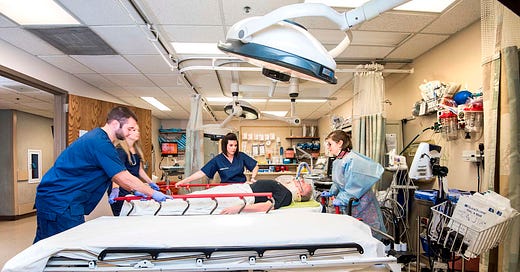July is upon us and it’s a big month in the world of medicine. July 1st is traditionally the day that medical school graduates start their residency training. It’s a time of anxiety for those physicians and also can be a time of confusion for people being seen and treated by them in hospitals and clinics. So, I thought it might be good to review the process of becoming a physician so that if you find yourself in a teaching hospital, you’ll understand who is who.
Let’s pretend you decide you want to be a physicians. You succeed in college and are accepted to medical school (either “allopathic” which means MD or “osteopathic” which means DO…they are essentially the same programs by the way).
Your parents are beaming and talking to their friends, and all of your relatives ask you to take their blood pressures. But what you really do is study endlessly for the first two years. Each semester of those first two years covers basic science topics needed to be a physician. And each semester accounts for about 20-25 credit hours. Along the way there are more tests, some in your classes and some standardized national tests.
Next, you’ll spend two years working and learning as a medical student in the hospital. You will continue to study and read, but will also do various rotations in medicine, pediatrics, surgery, radiology, intensive care, obstetrics and gynecology and pretty much everything the hospital has to offer. Third year students usually have a badge that indicates their student status; MS III stands for third year medical student, MS IV for fourth year, of course.
During those last two years you’ll spend around thousands of hours involved in clinical activities, working alongside physicians. But you’re just getting started! Because during that last year of school you’ll decide what flavor of doctor you’d like to be. And you’ll apply to various training programs, or residencies, in different places around the country depending on your own needs, interests and geographical requirements. They will have all of your application information and some will invite you for an interview. There’s a program called ‘The Match’ that takes your application and preferences and the preferences of the training programs, ‘ranks you’ and places you in a training program using a complicated computer algorithm and maybe magic.
There is much rejoicing and celebrating as you graduate from medical school, find an apartment in the new city, move and then on July 1, you go into the hospital with MD or DO after your name and begin to learn by treating patients at the bedside.
(There is slightly less rejoicing when you realize how much you’re working and do the math on your hourly income.)
There is also some terror at suddenly being at least partly responsible for the human lives and limbs trusted to your care.
First year residents are traditionally called ‘interns,’ or PGY 1 (that is, post-graduate year 1) residents and so on for years. Residency lasts anywhere from three years for some specialties like family medicine, pediatrics, internal medicine and emergency medicine all the way to seven years for some surgical specialties. Training can go on into further programs called “fellowships” in subjects like gastroenterology, cardiac surgery, intensive care, cardiology and others. Those in such programs are referred to, obviously, as “fellows.” And naturally, more tests called “board exams” follow residency and fellowship. Residency and fellowship will involve tens of thousands more hours of clinical education than medical school.
The next time you’re in a large hospital with teaching programs, whether July or any other time, you can now identify the species of doctor in the wild. And you may observe as with raccoons and other wildlife, “they’re just as scared of you as you are of them.” But the good news is, they’re really well educated and dedicated to their professions. So be kind, be patient and say a prayer for them.
They’re going to need all the prayers they can get.
Here’s funny, and accurate, breakdown of the ‘dangers’ of new residents.




I have taught in a family medicine residency program for 20 years now. It always amazes me to see young, freshly minted “doctors,” who barely know where the hospital bathrooms are, become in three years, competent, compassionate, and confident, physicians, whom I am proud to send forth into the world.
We start again today…